How to Make Perfect Cheese Sauce
Secrets for how to make perfect cheese sauce every time! Who doesn’t love a creamy cheese sauce? Follow these simple steps and you’ll never have grainy, lumpy, stringy or oily sauce again!
Simple ingredients, quick recipe that’s ready in 10-minutes!
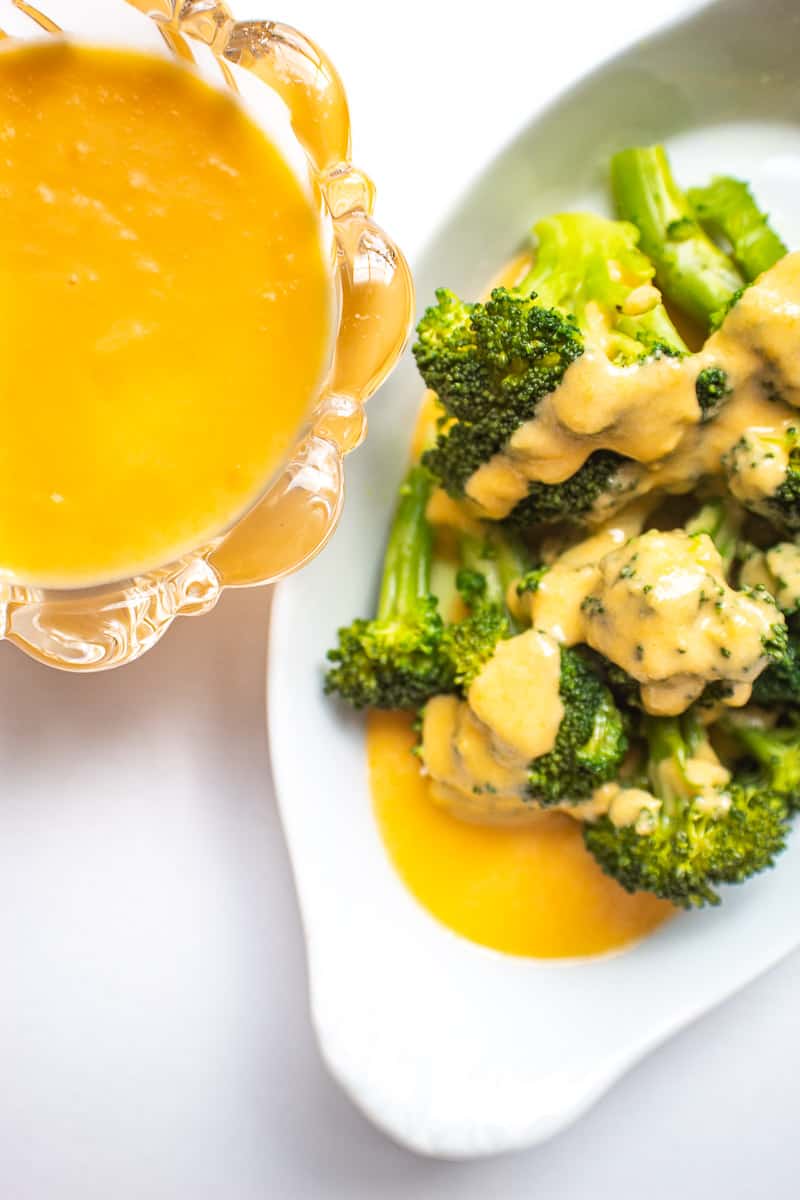
Everything tastes better with cheese, right? Keep this simple, foolproof recipe handy…once you make it, you’ll use it time after time!
My favorite way to serve this is with steamed broccoli, but it also goes well with asparagus or served as a nacho cheese sauce or on top of a chili cheese dog!
Why you’ll love this recipe!
Homemade cheese sauce doesn’t require a lot of meal prep or food science, just some basic tips:
- Works for different young cheeses – Cheddar, Colby, Monterey Jack, Mozzarella cheese
- Quick and Easy – ready in 10-minutes
- Simple ingredients – you probably already have everything you need
- Relatively keto-friendly cheese sauce – if you’re on a low carb diet, know that there’s just a small amount of wheat in this sauce
- Versatile – use as a sauce, dip or in a casserole
Once you learn how to make the perfect cheese sauce, you can explore different sauces!
Here’s what you’ll need
This easy cheese sauce, also known as “Mornay” sauce is a flour-based roux sauce derived from Bechamel sauce (or a basic white sauce), which one of the 5 French Mother Sauces. It is a roux-based sauce which means it contains equal amounts of fat and flour – in this case, butter and all-purpose flour.
All-purpose flour – just a little bit is needed to make this traditional cheese sauce
Butter – I use unsalted butter but if you have salted butter, that’s okay; just don’t add salt until you taste the cheese sauce
Milk-I use 2% milk, but you can use whole fat milk; or heavy cream or half-n-half. If you don’t have any of these, you can use evaporated milk
Cheddar cheese– I use sharp cheddar cheese but you can use mild cheddar if you prefer; just note: I do NOT recommend using pre-shredded cheese you get at the grocery store. It’s coated with an anticoagulant that prevents the cheese sauce from being a ice smooth and creamy texture
Lemon juice or white vinegar-just a small amount of acidity is added at the end of the cooking time to make this creamy cheese sauce more flavorful. You can also substitute with a little bit of dry white wine.
Seasonings: I use salt and white pepper, but you can certainly use ground black pepper, cayenne pepper (for a spicy kick), or add in a little onion powder or garlic powder
How to make a silky smooth cheese sauce
This homemade cheesy sauce recipe is easy to make, but the secret is to use a good cheese and cook it low and slow. First, in a large saucepan on low heat, melt butter, then add an equal amount of flour and whisk that together. It will be clumpy at this point, so don’t freak out. Cook it on low for 2-3 minutes.
Gradually add room temperature milk in 1/2 cup increments, whisking constantly
Once the roux and milk mixture is well combined, gradually add in shredded cheese a handful at a time; continue whisking and cooking on low heat
Season to taste with salt and pepper or, if you prefer a spicy cheese flavor, add a little cayenne pepper or smokey paprika
Serve immediately
Tips for making perfect cheese sauce
Use a young cheese – this is a pliable cheese aged less than one year. Young cheese has more moisture and melts better; aged cheeses have less moisture and tend to clump and separate, also known as “breaking.” Aged cheeses are more acidic and “hard cheese” like Parmesan. Cottage cheese and ricotta cheese are both high in acidity so avoid using these when making a sauce.
Use whole milk, not reduced-fat cheese: Reduced-fat cheeses have fat replacers that reduce the fat content; the replacers produce a stringy, rubbery texture
Shred or cube cheese from cheese block
Grated- grate cheese from a block of cheese; grating cheese increases the surface volume so the cheese melts better and faster; don’t use cubed or pre-shredded cheese; they are often coated with cellulose that does not respond to heat and prevent melting into a smooth consistency
Use room temperature cheese and milk– allow for better melting and reduces the possibility of sauce separation
Low heat-cheese will separate when added to a boiling liquid; to prevent separation, always use very low heat
Add acid-last and off heat; a teaspoon of lemon, vinegar or white wine when added to Cheddar, Colby and Monterey Jack will reduce the risk of the cheese forming clumps
Don’t over stir – continued stirring will cause separation
Serve it warm – if it cools, it will tend to clump
Highly acidic cheeses – Cottage cheese, Parmesan, Swiss, Emmentaler and Gruyere should be lightly dusted with cornstarch prior to melting because they’re more acidic
Cheese Sauce FAQ
If your sauce turned out grainy, it’s usually due to a few things:
The heat was too high – always cook cheese on low temperature to avoid separation
Not enough fat – Low-fat cheese or reduced-fat cheeses do not have enough fat in them; you’ll often see a grainy cheese sauce if you use either of these
Too much acid – in order to get a smooth, silky texture, you need to use a young cheese and add a little acid to the sauce; however, if you add too much, the result is grainy
If your sauce is grainy, it might be due to the age of the cheese or the cooking temperature.
If you find your sauce is gritty or grainy, you can try two things, but you must do them in this order.
Remove the pan from heat and whisk in a little milk or cream.
If this doesn’t resolve the issue, let the sauce cool a little, then add a little lemon or vinegar and whisk again-off heat
Remember, always add acids LAST. Do not add milk/cream and acid at the same time. Do not add acid first and then the cream.
You can thicken a thin cheese sauce by adding more cheese or adding a thickening slurry of either cornstarch or flour.
To create a thickening slurry, add 2 tablespoons of cornstarch or water to 3/4 cup of water; combine well and add to cheese sauce.
If you use a cornstarch slurry, turn the heat up to medium high, as cornstarch thickens at a higher temperature.
If you use a flour slurry, keep the heat on low and continue to stir until the sauce thickens to your desired thickness.
If your cheese sauce separates or begins to break, add in 1/4 cup of water to the sauce, raise the heat to medium-high or high, and whisk constantly. The high heat will re-emulsify the broken sauce.
Storage and reheating
Store the cheese sauce in an airtight container in refrigerator for up to 3 days. Freezing is not recommended. To reheat, use stovetop or microwave on low heat.
Sauce may thicken upon refrigeration, so you may have to add a little water. If so, heat cheese sauce in a saucepan on low, add in a little water and whisk, whisk, whisk. Turn the heat up a little when you’re whisking.
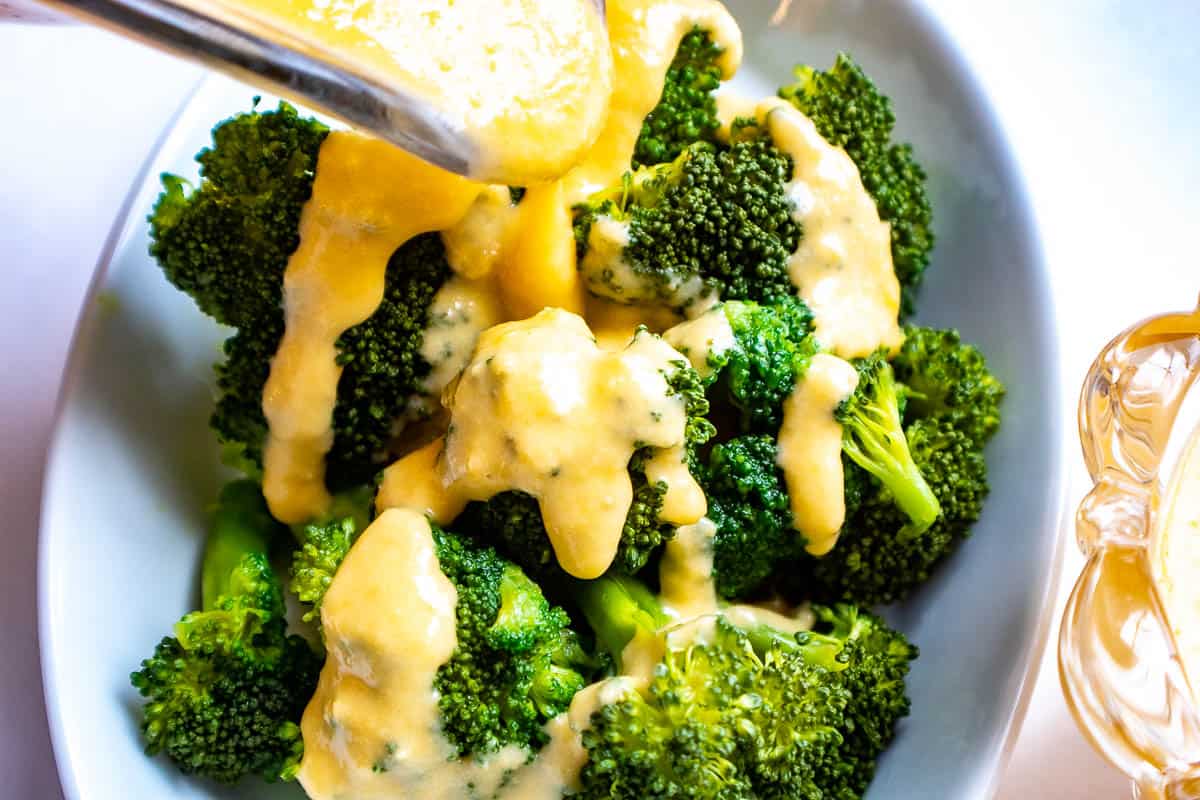
Making perfect cheese sauce isn’t hard at all! It pairs well with vegetables or as a dip!
Related recipes
If you make this recipe, please scroll down and leave a comment and rating! I love to hear from you!

Foolproof Perfect Cheese Sauce
Ingredients
- 4 tablespoons butter , salted or unsalted
- ¼ cup flour , all-purpose
- 1 cup milk , 2% or whole
- 8 ounces cheese , shredded from block, use a young cheese (see recipe notes)
- 1 teaspoon vinegar , white vinegar or lemon juice
- salt and pepper , to taste
Instructions
- On low heat, melt butter in saucepan4 tablespoons butter
- Sprinkle in flour; whisk¼ cup flour
- Add room temperature milk in ½ cup increments; continue to stir1 cup milk
- Add shredded cheese in increments, stirring in between8 ounces cheese
- Remove from heat; add vinegar; whisk till smooth1 teaspoon vinegar
- Taste for salt and peppersalt and pepper
Notes
- Use a young cheese – these are pliable cheeses that are aged less than one year; cheddar, colby-jack, Mozzarella and Monterey Jack are young cheeses.
- Use whole milk, not reduced-fat cheese: Reduced-fat cheeses have fat replacers that reduce the fat content; the replacers produce a stringy, rubbery texture
- Shred or cube cheese from cheese block
- Grated- grate cheese from a block of cheese; grating cheese increases the surface volume so the cheese melts better and faster; don’t use cubed or pre-shredded cheese; they are often coated with cellulose that does not respond to heat
- Room temperature cheese – allow for better melting
- Low heat-cheese will separate when added to a boiling liquid; to prevent separation, always use very low heat
- Add acid-last and off heat; a teaspoon of lemon, vinegar or wine when added to Cheddar, Colby and Monterey Jack will reduce the risk of the cheese forming clumps
- Don’t over stir – continued stirring will cause the cheese sauce to separate
- Serve it warm – if cheese sauce cools, it will tend to clump
- Highly acidic cheeses – Parmesan, Swiss, Emmentaler and Gruyere should be lightly dusted with cornstarch prior to melting because they’re more acidic

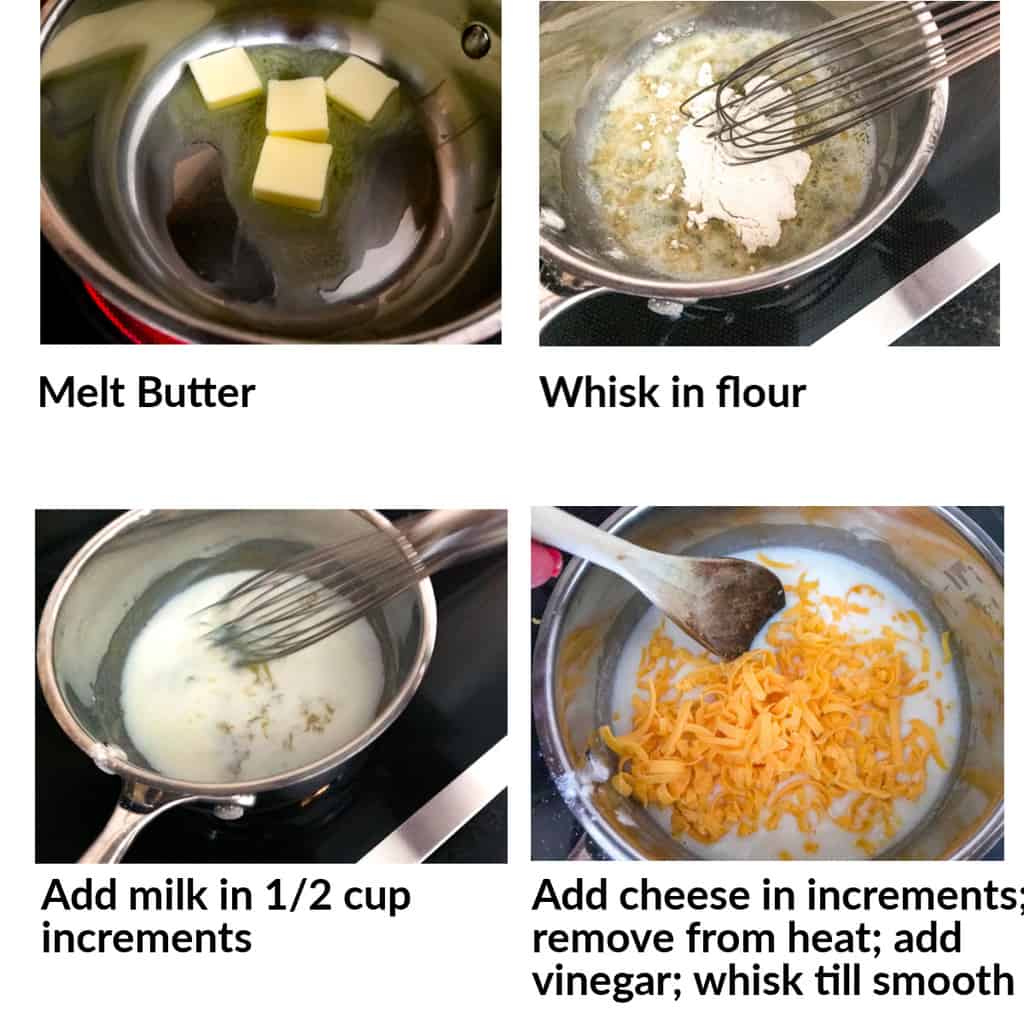


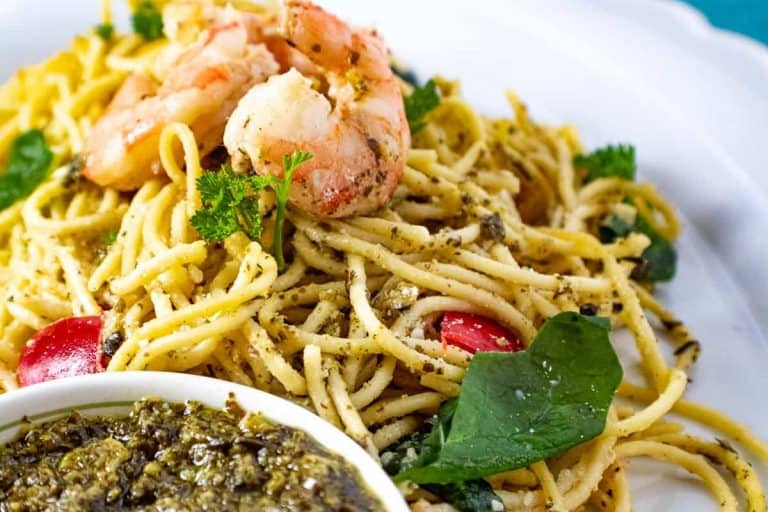
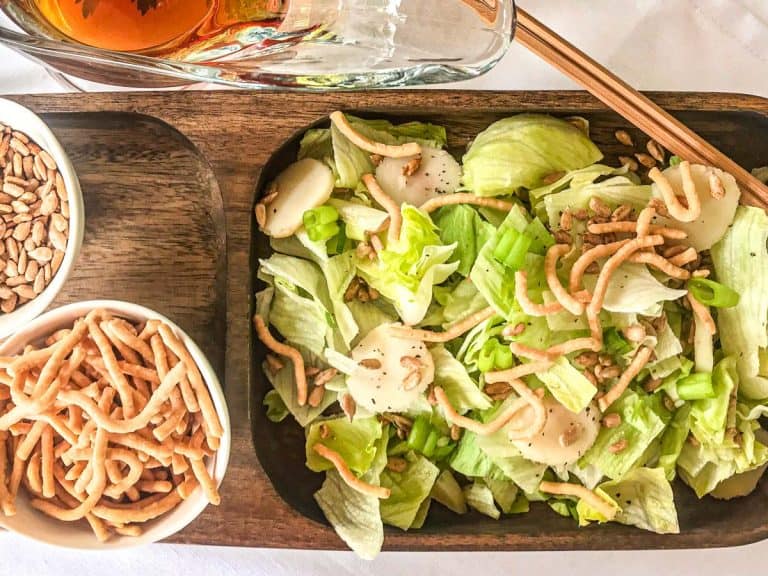
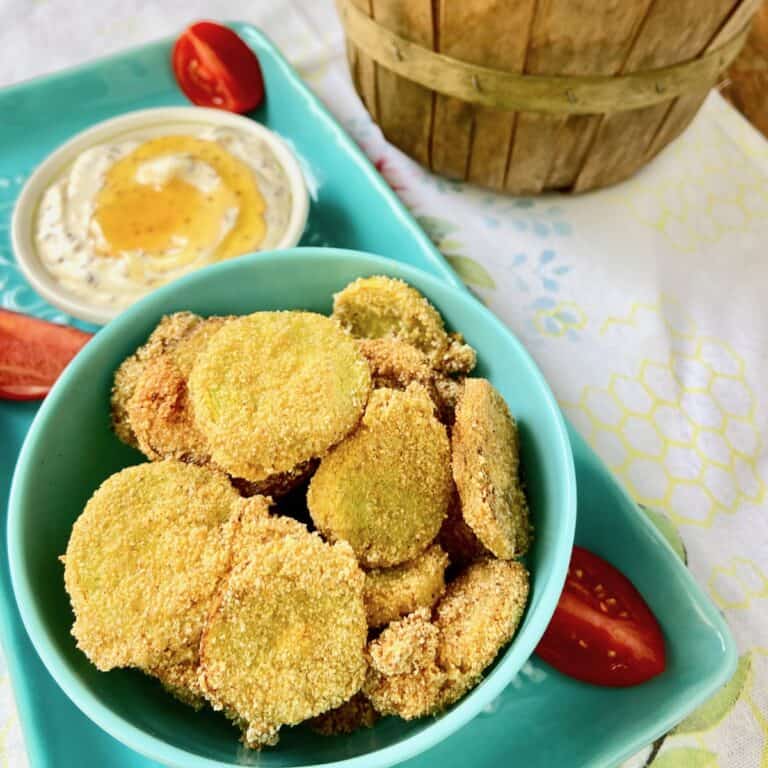

I use this recipe for my “go-to” cheese sauce on everything! LOL! Great recipe!
I never thought to put vinegar in cheese sauce. I’m going to try this next time!
Just a smidgen…it’s a food science thing:) …the acid works with the dairy proteins in some magical way to prevent clumping…you can also use wine or lemon juice…